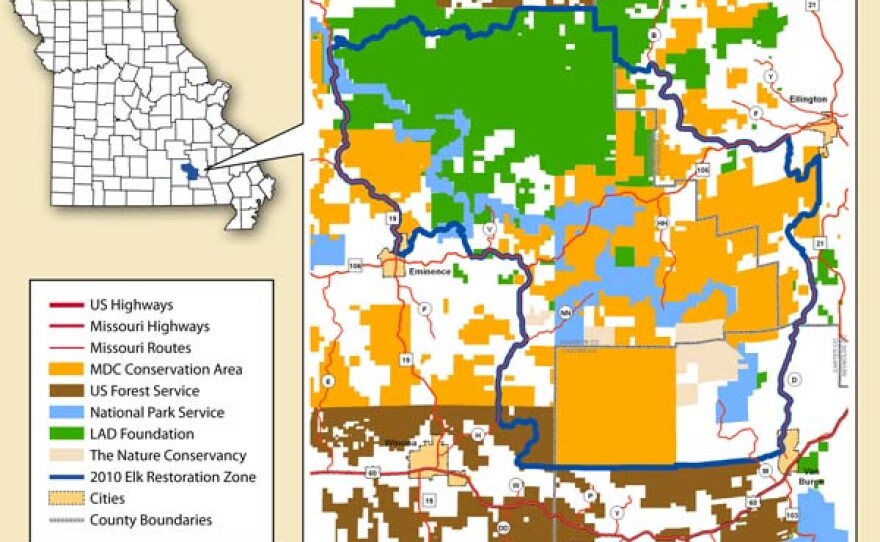You can also see photos of the elk and find out more about the reintroduction above. And, for more information about the elk restoration efforts prior to their arrival in Missouri, see the video below the story text.
http://stream.publicbroadcasting.net/production/mp3/national/local-national-966265.mp3
Starting tomorrow*, elk will be back in Missouri. They haven’t been here since the mid-1800s, when hunting and habitat loss drove eastern elk to extinction.
States from Arkansas to Pennsylvania have since reestablished their elk populations. And now Missouri is trying to do the same.
But not everyone is happy about the state’s elk reintroduction plans.
“Just, put us on the map!”
The call of a male elk bugling to attract a mate hasn’t echoed across the Missouri landscape in about 150 years.
The Missouri Department of Conservation hopes we’ll soon get to hear a lot more of them. With the help of its counterpart in neighboring Kentucky, the MDC is starting a new elk population in southeastern Missouri. The goal is to bring in 150 elk over the next few years and have the population grow to about 500 animals.
The small Ozark town of Eminence, Mo. sits on the western edge of the elk restoration zone. It’s already declared itself the “Elk Capital of Missouri.” Many of its 600 residents make their living at least in part from the tourists who come to float down local rivers and hunt deer and turkey. Eminence residents Jim Anderson, Billy Dewitt and Patty Frazier hope those bugling elk will help give tourism a boost:
“We hope it’ll help a little bit in the fall,” Anderson said. “Things die off here after about the middle of October and that’s about when the elk will be doing their thing.”
“It’s something new, it’s something to see, it’s something to go out and to enjoy while you’re out in the wilderness,” Dewitt said.
“I think it’s a great idea. I think it’ll bring more people into the area. Just, put us on the map!” Frazier said.
Protecting a way of life
But for some area residents, like life-long cattle rancher Bobby Simpson, those elk are dangerous, 500-plus-pound invaders. Simpson’s ranch near Salem is about 30 miles north of the elk restoration zone. He’s worried the elk won’t stay where they’re put, and will cause car accidents, break fences, and compete with livestock for forage.
“They’re a lot like cattle in the sense that they graze and they ruminate like cattle,” Simpson said. “So their primary diet’s going to be the same thing that our cattle are eating: our good grasses, and our good hay fields.”
Simpson says some people may not understand, but he wouldn’t hesitate to shoot an elk to protect his property and livelihood.
“We’re not against elk, and we’re not against wildlife,” Simpson said. “We just want to protect our way of life, and basically do what we’ve been doing down here for hundreds of years, and we just don’t need these problems brought onto us unless somebody’s going to be responsible for it. We’re just asking for the state to be responsible for their actions.”
Planning for complaints and the future
“We’ve developed a protocol to deal with elk that get on properties where they’re not wanted,” Lonnie Hansen, a resource scientist for the Missouri Department of Conservation said.
Hansen says MDC staff will be ready to respond to any complaints within 24 hours, to help landowners get unwanted elk off their property.
“We’d go in with sound cannons, or rubber slugs just to basically agitate and push the elk away from the area,” Hansen said. “Last resorts: trapping and relocating, and possibly shooting but we hope we don’t have to get to that.”
Hansen says the elk released in Missouri will be microchipped and fitted with GPS radio collars, so that researchers can track their movements and choice of habitats. And in four or five years, once the elk population gets large enough, the state plans to allow limited hunting outside the restoration zone, to help keep the elk inside its boundaries.
Missouri’s first elk are scheduled to arrive Saturday morning. They’ll have a few months to get used to their new surroundings before the area is opened to the public in July.
From construction to trapping to testing, this video from the Missouri Department of Conservation recaps some of the elk restoration efforts prior to their arrival in Missouri:
*From the Missouri Department of Conservation, an update (posted 10 a.m. May 2):
Arrival of elk at Peck Ranch has been delayed because all necessary health protocol testing is not complete, according to Ron Dent, elk restoration program coordinator for the Missouri Department of Conservation. Dent said MDC will select a new arrival date for the elk once health protocol testing is complete. Testing was inconclusive on one animal. Additional testing will be conducted on that one animal and results could be available as early as next week. Final testing is being completed and verified to ensure elk held in Kentucky meet the highest standard of health prior to arriving at their holding pen on Peck Ranch Conservation Area. The Department of Agriculture and the Department of Conservation continue to implement the strongest health testing protocols in the nation. Missouri’s elk restoration is moving forward and the Conservation Department will continue to keep citizens informed on this conservation initiative.
*Another update from the Missouri Department of Conservation (posted 9:17 a.m. May 3):
All 34 animals intended as the nucleus of an elk herd in Missouri have passed the final round of health testing and are ready to board a trailer for the trip to Peck Ranch Conservation Area. Missouri’s elk originally were scheduled to arrive April 30. The Missouri Department of Conservation delayed the event to permit completion of veterinary-health testing.











